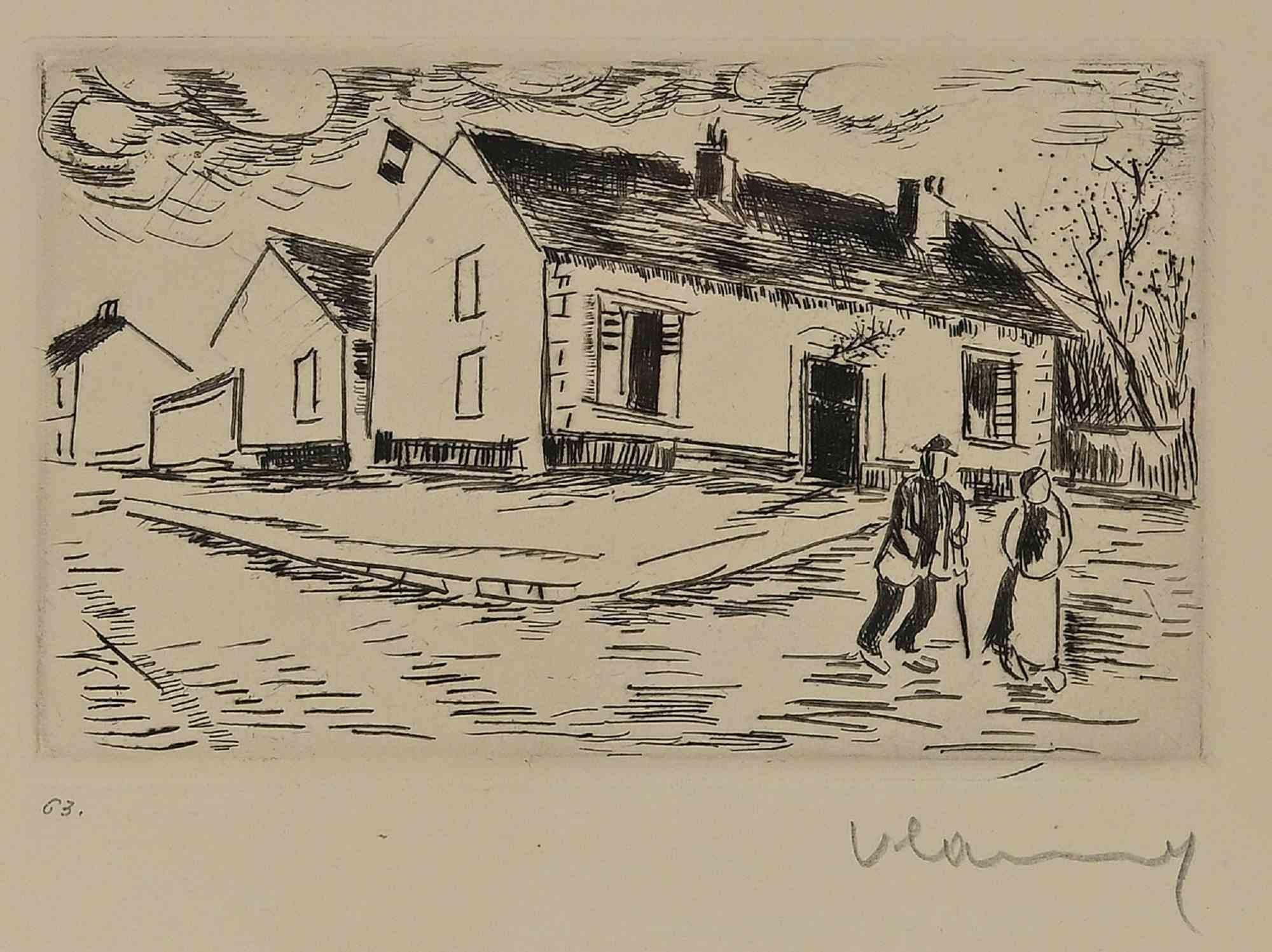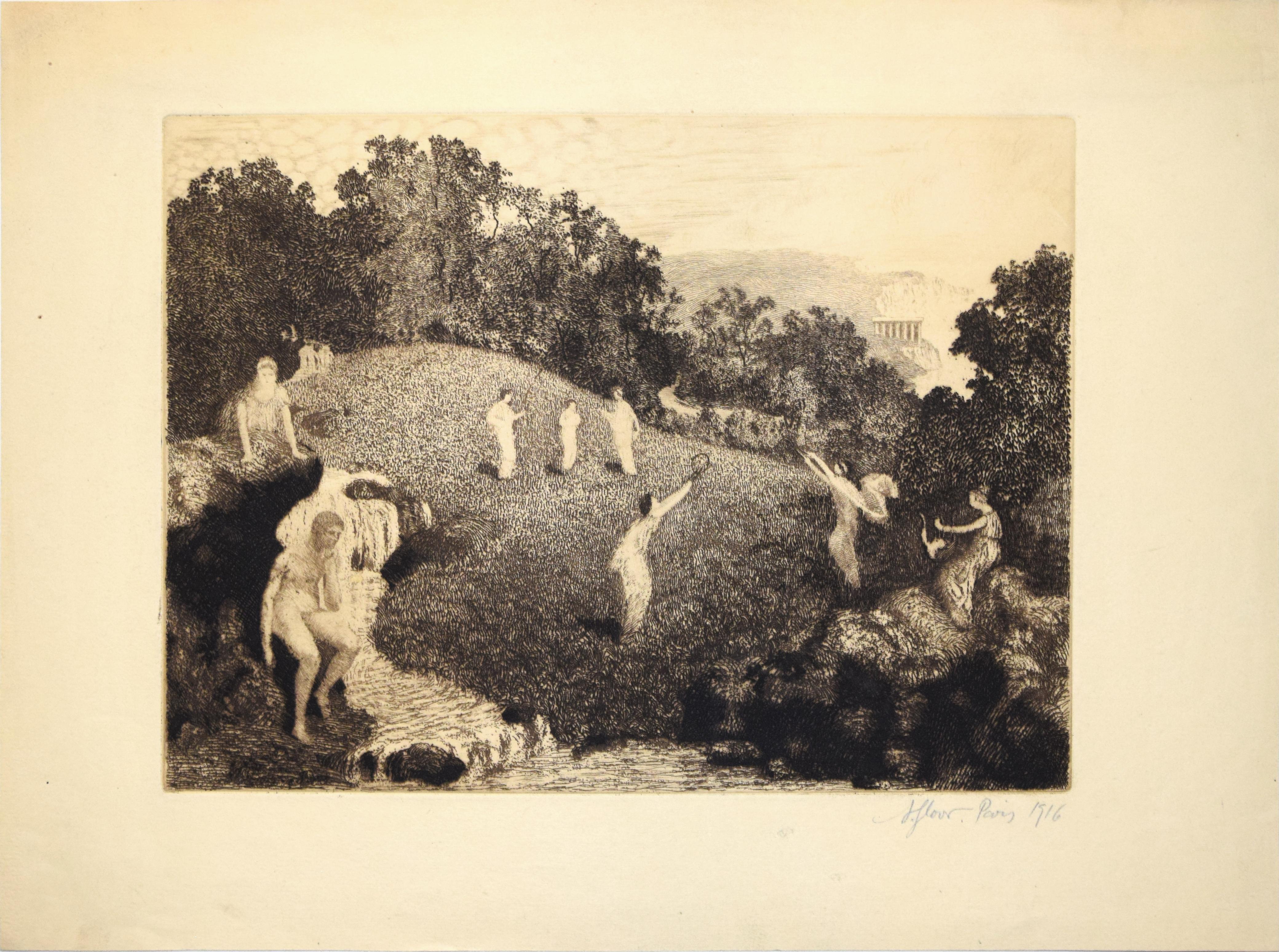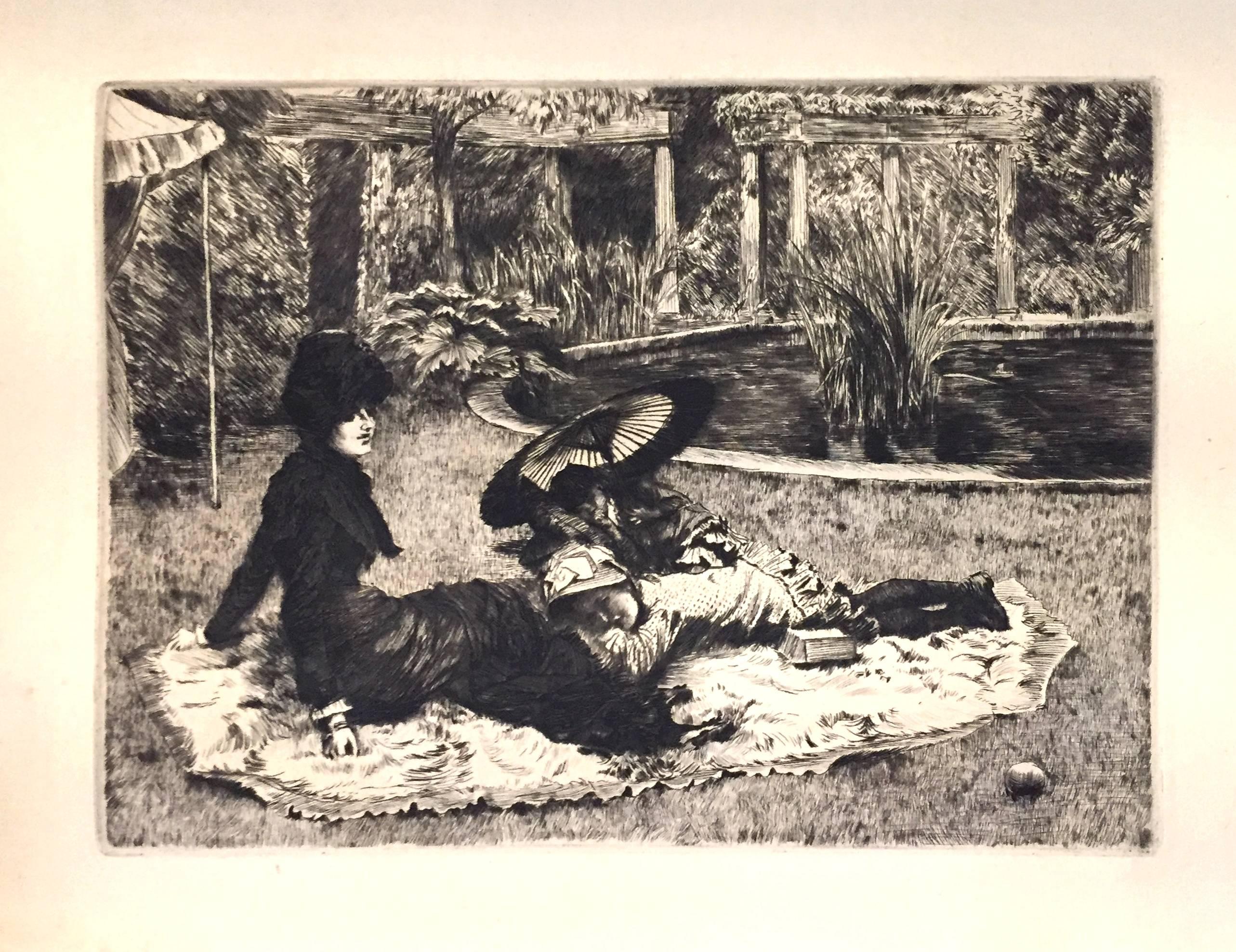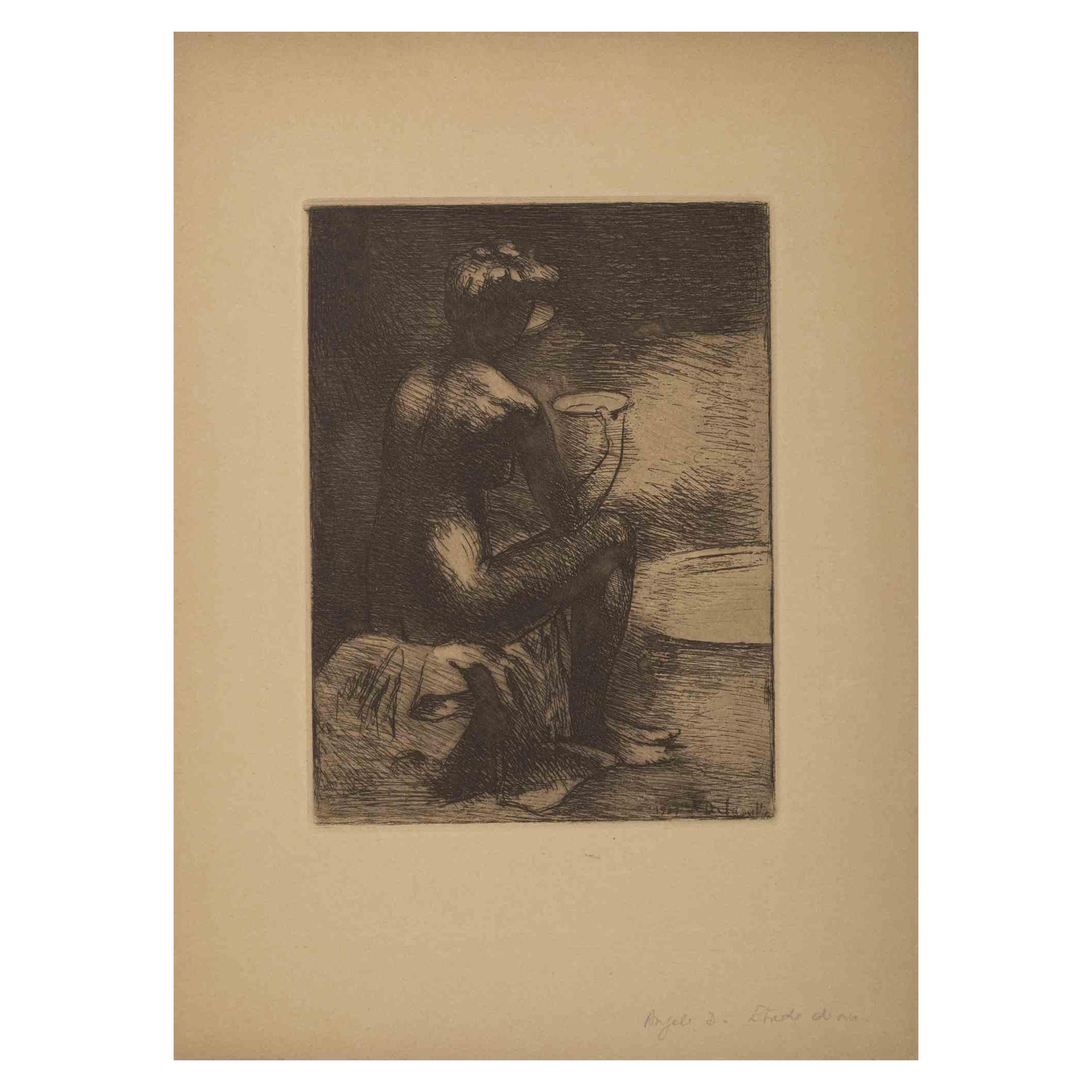Items Similar to La neige à Paris (Snow in Paris) - Etching by F. H. Buhot - 1879
Want more images or videos?
Request additional images or videos from the seller
1 of 5
Félix Hilaire BuhotLa neige à Paris (Snow in Paris) - Etching by F. H. Buhot - 18791879
1879
About the Item
Wonderful etching, aquatint, drypoint, and wheel on laid ivory colored paper. Signed inside out on plate on the lower margin at the center. Each image of the composition is hand-titled on the plate on lower margins. Fourth state on nine. Edition of the “L’Art. Excellent conditions, including ivory colored cardboard passe-partout (cm 33.5 x 49).
The print has been given the titles of “L’Hiver à Paris “ or “ La Neige à Paris”. The modern artwork represents the rigorous winter of 1879 with Arctic temperatures and vast quantities of snow covered the Parisian streets.
Reference: B.G. I28
The present print, one of his best known, exemplifies these preoccupations. The published version appeared in the journal L'Art (n° 314) in January 1881.
As Bourcard clearly states "There were numerous trial proofs pulled and an extraordinary variety of printings in the various impressions of this plate. There exist a few rare artist's proofs of the state before the words: L'Art, the number 25, L'Hiver de 1879 à Paris."
Félix Hilaire Buhot (1847 - 1898)
Along with artists like Charles Jacque, Louis Monziès and Félix Bracquemond, Félix Hilaire Buhot contributed to the reviving seventeenth-century etching techniques in late nineteenth-century art. As we could see in this artwork the French artist was highly experimental and regularly employed technical variables and regularly combined multiple processes to produce a single print. He used traditional techniques of etching, drypoint, and aquatint along with modern methods such as photomechanical reproduction.
Buhot invented the "marges symphoniques" (symphonic margins); particularly he developed two types of margins, etching the first on the same plate as the central subject and printing the second, called a “false margin,” from a separate plate. His sources of inspiration were the marginal decorations of medieval manuscripts and eighteenth-century French book illustrations.
He is called the painter of atmosphere, because in many of his prints of city view and seascapes he represented the effects of weather such as rain, mist, fog, or, as in this case, snow
- Creator:Félix Hilaire Buhot (1847 - 1898, French)
- Creation Year:1879
- Dimensions:Height: 11.42 in (29 cm)Width: 16.93 in (43 cm)Depth: 0.04 in (1 mm)
- Medium:
- Movement & Style:
- Period:
- Framing:Framing Options Available
- Condition:Insurance may be requested by customers as additional service, contact us for more information.
- Gallery Location:Roma, IT
- Reference Number:
About the Seller
4.9
Platinum Seller
These expertly vetted sellers are 1stDibs' most experienced sellers and are rated highest by our customers.
1stDibs seller since 2017
6,717 sales on 1stDibs
Typical response time: 2 hours
- ShippingRetrieving quote...Ships From: Monaco, Monaco
- Return PolicyA return for this item may be initiated within 14 days of delivery.
More From This SellerView All
- Village - Etching by M. de Vlaminck - 1950By Maurice de VlaminckLocated in Roma, ITVillage is a modern artwork realized by Maurice de Vlaminck in 1950. Black and white etching. Hand signed and dated on the lower margin. Edition of 100 specimen as reported on th...Category
1950s Post-Impressionist Landscape Prints
MaterialsEtching
- Figures in the Landscape - Etching by J. A. Flour - 1916By Jules Adrian FlourLocated in Roma, ITFigures in the Landscape is an original artwork realized by Jules Adrian Flour in 1916. Original etching on paper. The artwork is glued on cardboard. Hand-signed in pencil by the ar...Category
1910s Post-Impressionist Figurative Prints
MaterialsEtching
- Au Bois de Boulogne - Original Etching by H. Farge - Mid 20th CenturyLocated in Roma, ITImage dimensions: 16 x 11 cm. Au Bois de Boulogne is an original modern artwork realized in the first decades of the XX Century by the French artist Henri Farge...Category
Mid-20th Century Post-Impressionist Figurative Prints
MaterialsEtching
- On the Grass - Etching and Drypoint by J. Tissot - 1880By James TissotLocated in Roma, ITVery fine print on verge crème. Some small traces of oxidation, dust and some flowerings on external edges of sheet, otherwise excellent conditions. Full margins. Ref. Wentworth 50.Category
1880s Post-Impressionist Landscape Prints
MaterialsDrypoint, Etching
- Study for a Nude - Original Etching by A. Delasalle - Mid-20th CenturyBy Angèle DelasalleLocated in Roma, ITStudy for a Nude is a contemporary artwork realized by the French artist Angèle Delasalle in the Mid-20th Century. Original etching and drypoint. Si...Category
Mid-20th Century Post-Impressionist Figurative Prints
MaterialsEtching
- Working - Original Etching by A. Delasalle - Mid-20th CenturyBy Angèle DelasalleLocated in Roma, ITWorking is a contemporary artwork realized by the French artist Angèle Delasalle in the Mid-20th Century. Original etching and drypoint. Signed and ...Category
Mid-20th Century Post-Impressionist Figurative Prints
MaterialsEtching
You May Also Like
- "When Day is Done, " an Original Etching signed by John Edward CostiganBy John Edward CostiganLocated in Milwaukee, WI"When Day is Done" is an original etching and aquatint signed lower right in pencil by the artist John Edward Costigan. It depicts a man and a woman with their young child at the end...Category
1930s Post-Impressionist Figurative Prints
MaterialsEtching, Aquatint
- Catherina Dorothea Viehman (Six Fairy Tales from the Brothers Grimm) HockneyBy David HockneyLocated in New York, NYCatherina Dorothea Viehman (from Six Fairy Tales from the Brothers Grimm) Etching and aquatint on W S Hodgkinson paper watermarked "DH" and "PP" Paper 1...Category
1960s Modern Figurative Prints
MaterialsAquatint, Etching
- Rapunzel, Rapunzel let down your Hair (Six Fairy Tales from the Brothers Grimm)By David HockneyLocated in New York, NYSheet from “Rapunzel” story (from Six Fairy Tales from the Brothers Grimm) Text printed letterpress and “Rapunzel, Rapunzel let down your Hair” etching and aquatint on W S Hodgkinson paper watermarked "DH" and "PP" Etching 10.5 × 9.85 in. / 26.7 × 25 cm Paper 17.5 x 12.25 in. / 45 x 31 cm Unsigned: apart from the published edition of 400 books and 100 portfolios. This is one of eleven images recently found in our archive which we have decided to make available. There is one only of each image. Perhaps the most famous story from the Grimm Brothers, Rapunzel spins the tale of a beautiful young princess locked away by an evil sorceress. Captured in this scene is the moment a King's son came across the tower and fell in love with her sweet singing, beseeching her: 'Rapunzel, Rapunzel, Let down your hair to me.' Though the sorcerer banishes Rapunzel and maims the prince, they are of course ultimately reunited to live happily together. Hockney illustrates this scene with incredible texture detail: layers of aquatint defining the soft forest floor, delicate hatching on the horse's haunch, the tower's tight crosshatching, and of course the lyrical gesture of Rapunzel's hair which cascades from the upper right corner. This print from our publisher's archives is one of thirty-nine etchings from David Hockney’s 1969 "Six Fairy Tales from the Brothers Grimm". Hockney worked on this series with Paul Cornwall-Jones at Petersburg Press over the course of a year. 400 books and 100 portfolios plus artist’s proofs were printed. The artist illustrated six stories: 'The Little Sea Hare', 'Fundevogel', 'Rapunzel', 'The Boy who left Home to learn Fear', 'Old Rinkrank' and 'Rumpelstilzchen'. According to Hockney, "They're fascinating, the little stories, told in a very, very simple, direct, straightforward language and style, it was this simplicity that attracted me. They cover quite a strange range of experience, from the magical to the moral." He was inspired by earlier illustrators of the tales, including Arthur Rackham and Edmund Dulac, but Hockney reimagined the stories for a modern audience. The frontispiece for the project pictures Catherina Dorothea Viehmann, the elderly German woman who recounted fairy tales to the Grimm brothers when they were in their late twenties. In Hockney's words: “The stories weren’t written by the Brothers Grimm…they came across this woman called Catherina Dorothea Viehmann, who told 20 stories to them in this simple language, and they were so moved by them that they wrote them down word for word as she spoke.” Hockney drew the German woman in the style of Dürer, formally posed yet naturalistic against an impeccably crosshatched swath of grey. Hockney wrote about the surreal plots contained in the Brothers Grimm tales: “…the stories really are quite mad, when you think of it, and quite strange. In modern times, it’s like the story of a couple moving into a house, and in the next door’s garden they see this lettuce growing: and the wife develops this craving for the lettuce that she just must have and climbs over to pinch it, and the old woman who lives in the house next door says well, you can have the lettuce if you give me your child, and they agree to it. And if you put it into terms like this and imagine them in their semi-detached house agreeing to it all, it seems incredible.” Hockney enhanced this unbelievable quality with his illustrations which traverse inky, dense areas of intense crosshatching and minimalist line work. Rather than serving as direct interpretations of the plot, the images capture moments and feelings. Some portray the magic yet mundane -- Rapunzel's tiny face gazing placidly at a well-tended garden, or project danger and unease as in The Haunted Castle, with its citadel perched atop craggy rocks, dramatically lit against a dark sky. Hockney's sense of humor comes through in Cold Water About to Hit the Prince, in which a man tucked into bed stares straight at a rush of water drawn with a splash (this technique is likely Spit Bite, and the resultant bold spattered brushstroke contrasts beautifully with the rest of the carefully crosshatched image). A Wooded Landscape, with its lush textures, conveys the bucolic setting of a fairy tale and the potential danger hidden within the woods -- the viewer is left to wonder who lives on the hilltop in that diminutive cabin. These etchings defy the conventions of beautiful fairy tale illustrations...Category
1960s Modern Landscape Prints
MaterialsEtching, Aquatint
- Salvador Dali - The Beloved Feeds Among the Lilies - Signed AquatintBy Salvador DalíLocated in Collonge Bellerive, Geneve, CHSALVADOR DALI (1904-1989) THE BELOVED FEEDS AMONG THE LILIES, 1971 Board for the series "The Song of Songs hymns" Aquatint and dry point on wove paper...Category
1970s Surrealist Figurative Prints
MaterialsDrypoint, Aquatint
- Mississippi Street IntersectionBy Robert BechtleLocated in Palo Alto, CACreated in 2007, this color soft ground etching with aquatint on paper is hand-signed and dated by Robert Bechtle (San Francisco, 1932 - Berkeley, 2020)...Category
Early 2000s Photorealist Landscape Prints
MaterialsEtching, Aquatint
- Hong KongBy Richard HaasLocated in New York, NYRichard Haas Hong Kong, 1990 Etching and Aquatint on wove paper Hand Signed, numbered and dated on the front Frame included; held in the original vintage hand made wood frame done by PSG This impressive, framed lithograph of Hong Kong is by Richard Haas - the world's foremost architectural muralist and trompe l'oeil artist whose prints and paintings are held and exhibited in many private, public and institutional collections. It is framed and ready to hang. Haas - who, aside from his many artistic distinctions, was profiled several years back by the prestigious CBS News...Category
1990s Realist Figurative Prints
MaterialsEtching, Aquatint
Recently Viewed
View AllMore Ways To Browse
Eighteenth Century French
Eighteenth Century France
Rare Manuscripts
Charles Wheeler
Etching Medieval
Antique Wheel Covers
Winter Fog
Post Modern Book Cases
Felix Bracquemond
Felix Buhot
Yellow Metal Wall Art
Italian Hand Painted Bed
September Wedding
Japan Louis Vuitton
African American Person
Louis Vuitton Pop
Matisse Vintage Art
Bicycle Drawing





